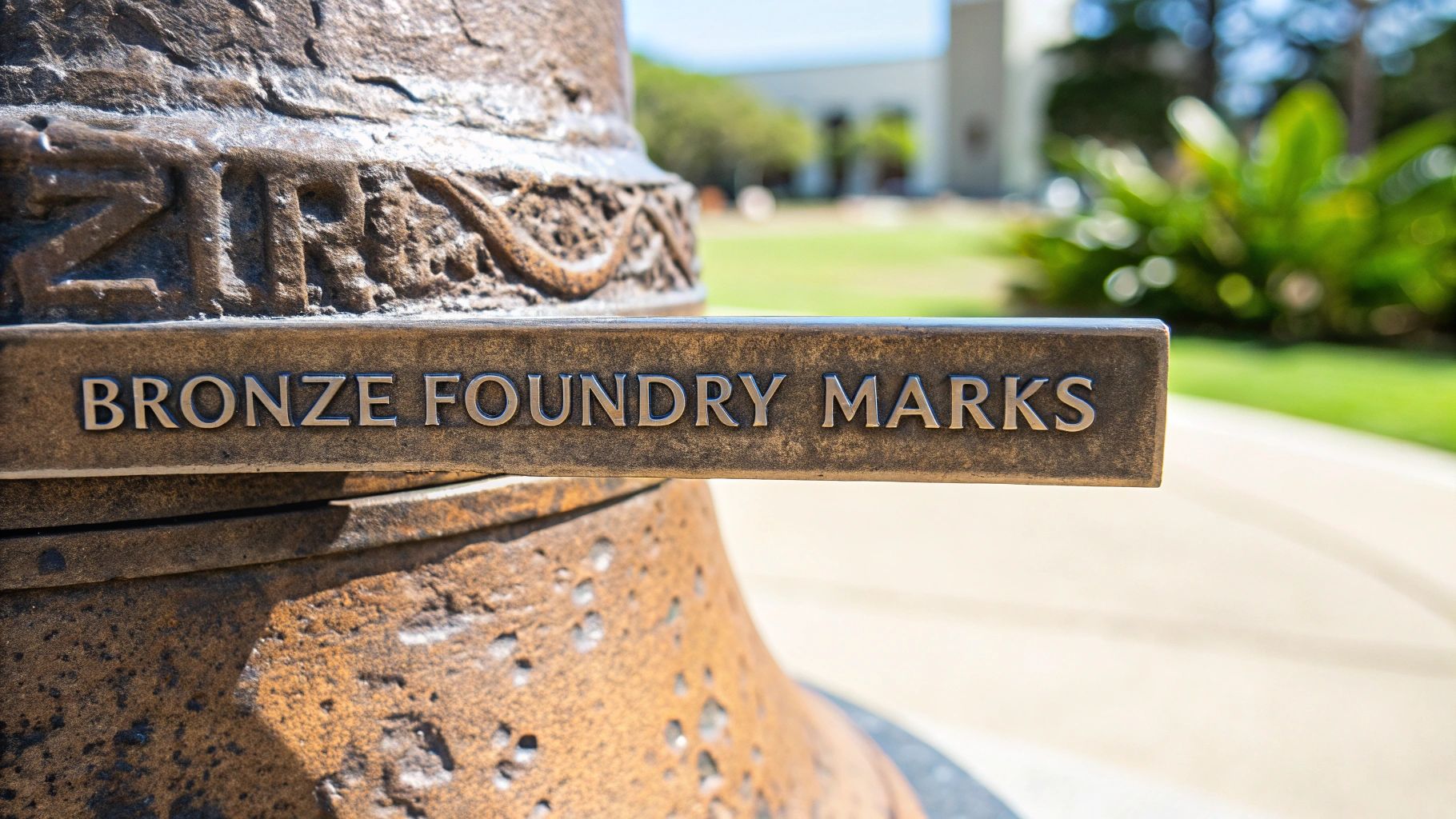Think of a foundry mark on a bronze sculpture as its fingerprint. It’s the unique stamp or signature left by the workshop that cast the piece, and it's absolutely crucial for verifying its origin and quality. For collectors and appraisers, these marks are the key to authentication, dating, and tracing a sculpture's history.
What a Foundry Mark Really Tells You
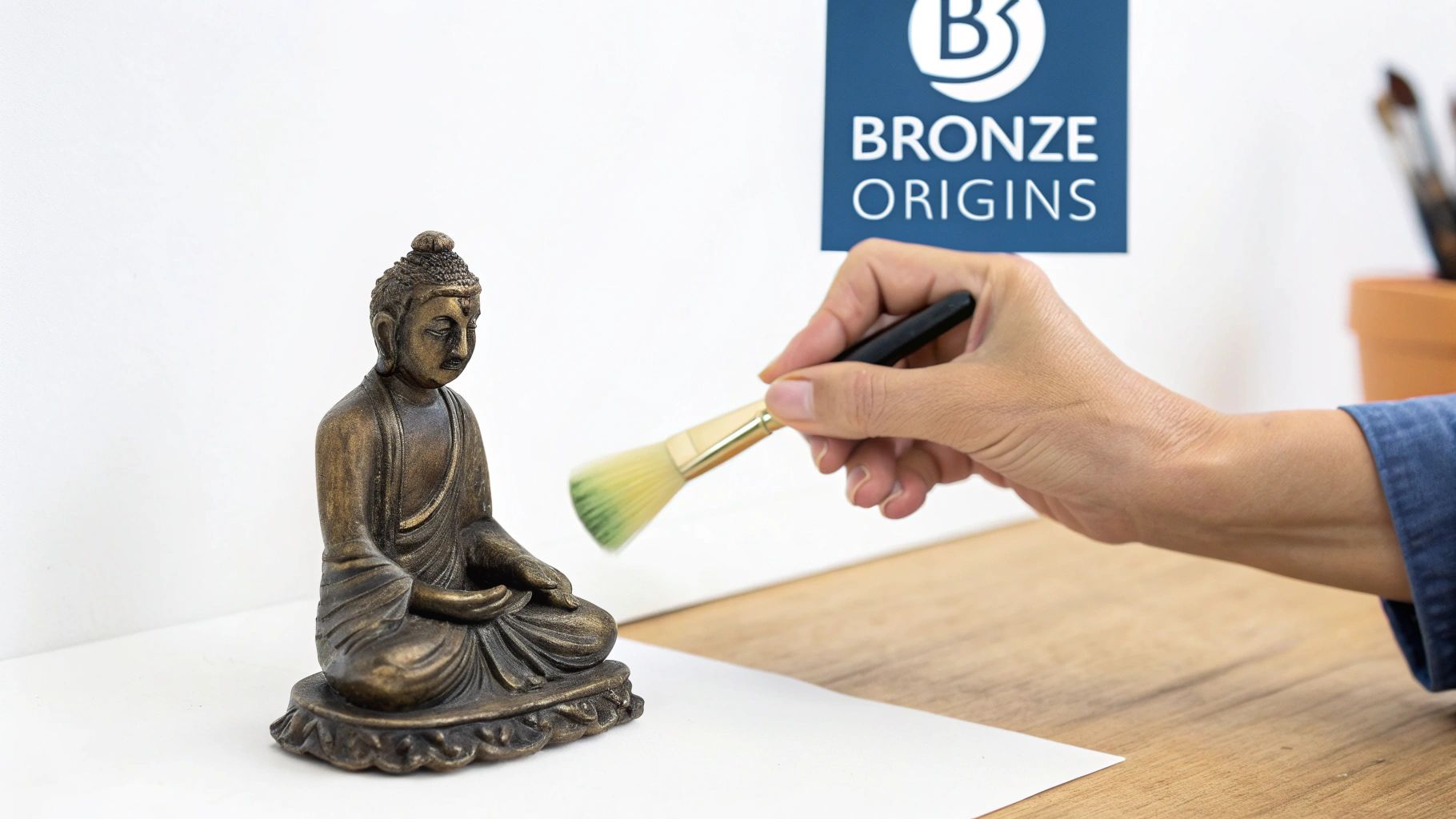
Essentially, a foundry mark is a seal of approval or a trademark. It directly ties a bronze sculpture to the artisans who brought it to life. If you're serious about bronzes, learning to read these marks isn't just a good idea—it's a fundamental skill that speaks to the quality of the casting and offers a window into its past.
The details you can glean from bronze foundry marks can be surprisingly varied. Some are as simple as a monogram or symbol. Others might spell out the foundry's full name, its city, or even include a special character that indicates the specific casting method used. All of this information is a cornerstone of the appraisal process.
Why Marks Are So Critical for Valuation
A mark from a renowned foundry can send a sculpture's value soaring. Why? Because it confirms the piece isn't a later copy or an outright fake. That small stamp provides a tangible connection to a specific moment in art history, giving collectors confidence.
This is especially true when you consider the scale of the industry. The global foundry market, which handles all kinds of metal casting, was valued at around USD 139.5 billion in 2025 and is expected to hit nearly USD 180 billion by 2030. With that much metal being cast, being able to pinpoint an authentic fine art bronze is more important than ever.
To a collector, a foundry mark is far more than a simple inscription. It's a vital part of the sculpture's story and a key to unlocking its true worth.
Ultimately, learning to correctly identify these marks is one of the first and most important steps in any authentication journey. To build on these skills, check out our comprehensive guide on how to identify antiques, as many of the same principles apply.
How to Read Different Types of Foundry Marks
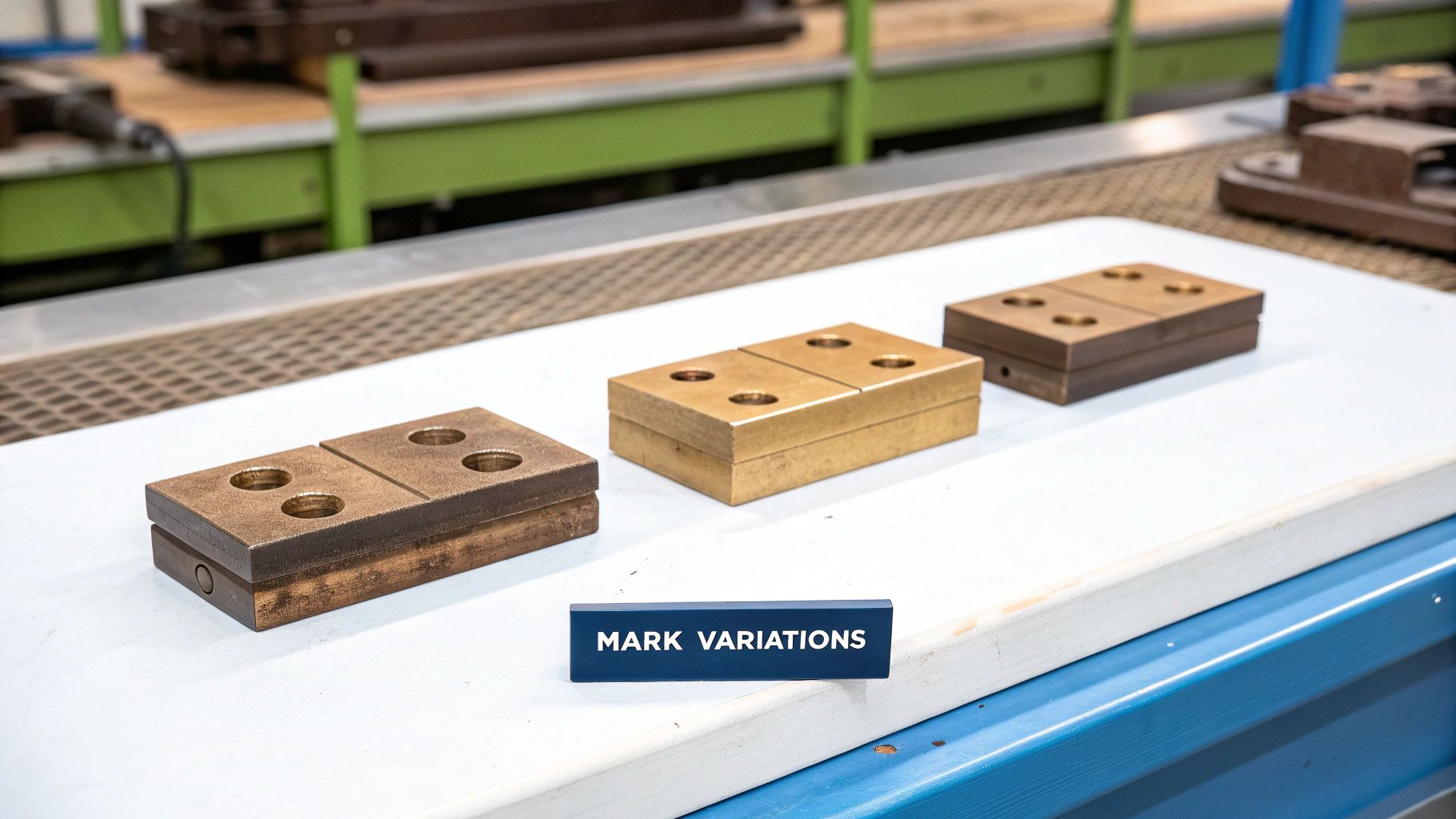
When you're trying to understand the foundry marks on bronze, it's about more than just reading a name. You're really learning to interpret a specific language—one told through the style, technique, and location of the mark. Every mark tells a piece of the sculpture’s story, from how it was made to the artist's original vision. Learning to spot these differences is your first real step toward a confident appraisal.
Marks are typically made in one of two ways: they are either impressed or incised. An impressed mark is made by pressing a stamp into the soft wax model before the bronze is even cast, leaving raised letters on the final piece. On the other hand, an incised mark is cut directly into the metal after casting. This basic difference is often the first clue you'll get about a foundry's methods and the era it operated in.
Decoding Impressed and Stamped Marks
Impressed marks often look a lot like a modern logo or trademark, and for good reason. They usually point to a larger, more established foundry that had a standardized way of doing things. You'll notice these marks are consistent and uniform across multiple pieces, which makes them much easier to look up in reference guides. They're most common on commercially successful sculptures that were produced in larger editions.
Look for these common types of impressed marks:
- Full Foundry Name: This is the most direct mark you can find, clearly stamped with the full name like "ROMAN BRONZE WORKS N.Y."
- Initials or Monograms: Think of the stylized "F. Barbedienne, Fondeur" mark, a stamp that quickly became a hallmark of quality in 19th-century Paris.
- Symbols or Emblems: Some foundries adopted a unique symbol. For a great example, look at the work of Viennese artist Franz Bergman, who used a capital 'B' inside a two-handled vase to sign pieces from his foundry. It was a memorable visual signature.
Where the mark is placed also says a lot. Foundries were careful not to spoil the look of the artwork, so you'll usually find marks tucked away in discreet spots—on the back of the base, under a sculpted fold of cloth, or along the bottom edge.
Understanding Incised Signatures and Marks
Unlike the neat, uniform look of stamped marks, incised marks are added by hand after the bronze has been cast and cooled. This technique was a favorite of smaller, more artisanal foundries or even by artists who were deeply involved in the casting themselves. As a result, these marks can feel more personal, and sometimes a little less perfect.
An incised signature can also hold a few secrets. For instance, Franz Bergman sometimes used the incised pseudonym "Nam Greb"—his last name spelled backward—on his more erotic works to keep them separate from his main studio's reputation. A unique, hand-carved mark like this adds a fascinating layer of personal history to a sculpture.
To help you quickly identify what you're looking at, here’s a simple table breaking down the common types of marks and what they usually mean.
Common Foundry Mark Types and Their Characteristics
| Mark Type | Appearance | Common Placement | What It Signifies |
|---|---|---|---|
| Impressed Stamp | Raised, uniform letters or symbols. Looks machine-made. | On the back, base, or along a lower edge. | A larger, established foundry with standardized production. |
| Incised Signature | Hand-carved or engraved, can be less uniform. | Discreet areas, but placement can vary. | A smaller foundry, direct artist involvement, or a later addition. |
| Monogram/Symbol | Stylized initials or a unique emblem (impressed or incised). | Often integrated into the base or a non-focal area. | A strong brand identity for a specific foundry or artist workshop. |
| Full Name | The complete foundry name, clearly spelled out (usually impressed). | Prominently on the base or rear of the sculpture. | Straightforward identification; common in the 19th and 20th centuries. |
Ultimately, the style of a mark—whether it’s a clean, mechanical stamp or a freely scribbled signature—is a direct echo of the foundry's personality and the time it was made.
By looking closely at how a mark was applied, you can start to piece together the history of your bronze sculpture. You'll move beyond just a simple name and toward a much richer appreciation of its journey.
Identifying Marks from Major Art Foundries
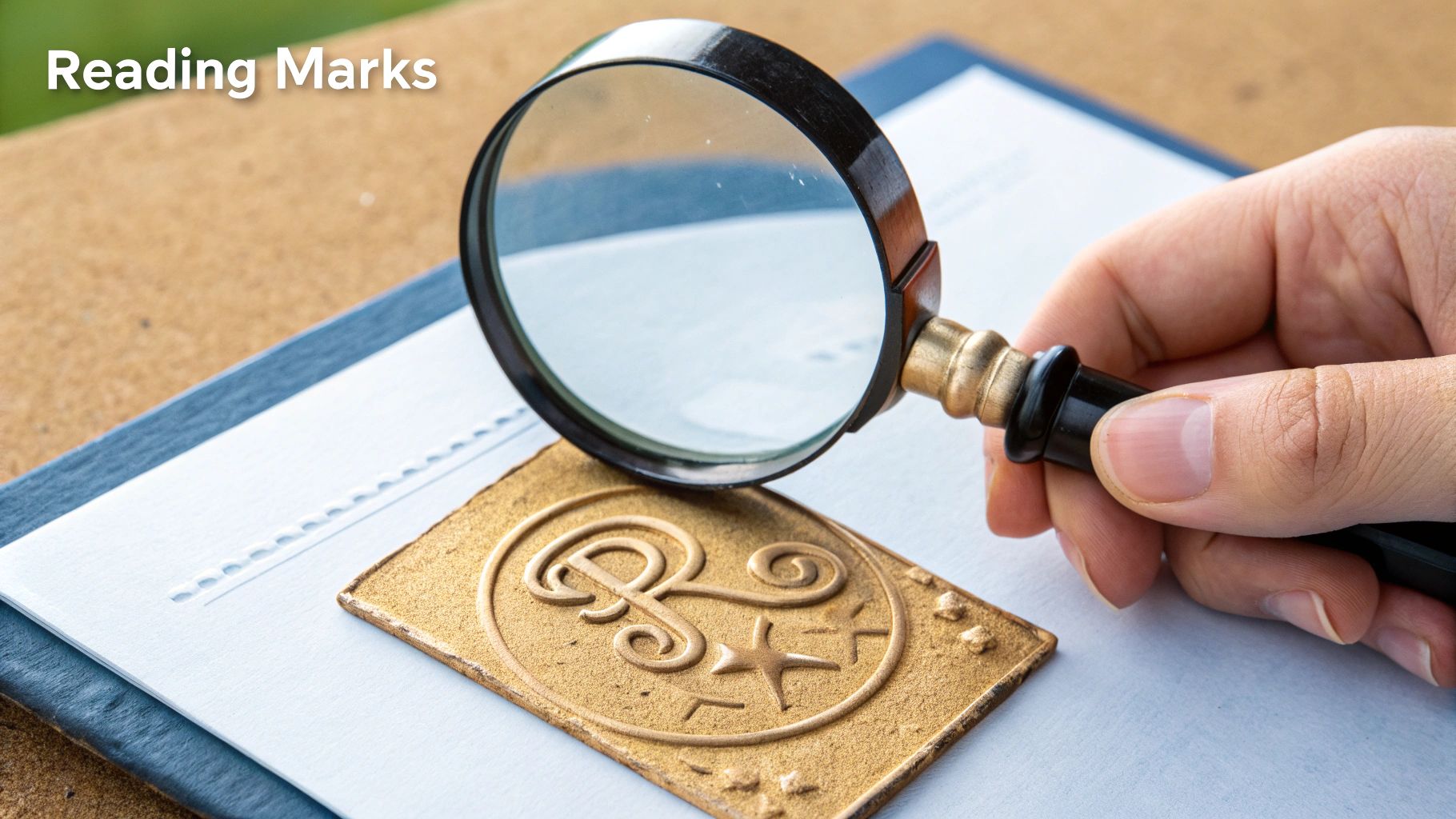
In the world of bronze sculpture, some foundry names just carry more weight. Seeing their mark is often a sign of exceptional quality and historical importance. A genuine foundry mark on bronze from one of these titans can seriously boost a piece's value.
This guide is built for quick lookups. Below, you’ll find the essential details on some of the most influential foundries in history. Each entry breaks down their years of operation, the famous artists they worked with, and what their distinctive marks look like. Think of it as a field guide for narrowing down the origin of your bronze.
Barbedienne Foundry Paris
The F. Barbedienne foundry was a force of nature in 19th-century French bronze casting. Running from 1838 to 1954, it was the brainchild of Ferdinand Barbedienne, a man who understood both quality and marketing. He cast for legendary sculptors, including giants like Antoine-Louis Barye and Auguste Rodin.
- Signature Mark: The most common mark is the stamped name "F. BARBEDIENNE, FONDEUR" in all caps.
- Dating Clues: The signature's style is a great tell. Earlier works sometimes have a more fluid, script-like stamp, while later pieces tend to have a cleaner, block-letter look.
- Special Marks: Barbedienne was an early adopter of the A. Collas reduction machine, which could create sculptures in various sizes. Pieces made with this technology often bear a special "Collas" seal.
Finding a Barbedienne mark is a fantastic sign you're looking at a high-quality 19th or early 20th-century cast.
Susse Frères Paris
Another Parisian giant, Susse Frères, had an unusual start. The company began with paper goods way back in 1758 before pivoting to bronze casting in 1839. Incredibly, it’s one of the oldest art foundries still operating today. They earned a reputation for their gorgeous patinas and cast for artists like Pierre-Jules Mêne and Jean-Baptiste Carpeaux.
The foundry’s mark changed over its long history, which is a gift to collectors trying to date a piece.
If there's one thing to remember, it's that foundries didn't always stick to one mark. By researching the specific style of a "Susse Frères" stamp, you can often pinpoint a bronze to a surprisingly narrow time frame, which is invaluable for an appraisal.
- Common Marks: Keep an eye out for an impressed stamp, often circular, that says "SUSSE FRES" or "SUSSE FRERES EDITEURS PARIS."
- Signature Mark: Many of their bronzes also include the foundry's cachet (stamp) right next to the words "CIRE PERDUE" (lost wax), proudly advertising their casting method.
Roman Bronze Works New York
Hopping over to the United States, we have Roman Bronze Works of New York City, a true game-changer. Founded in 1897 by Riccardo Bertelli, this was the first American foundry to focus solely on the lost-wax casting process. This dedication to the craft attracted the biggest names in American sculpture at the time, most notably Frederic Remington and Charles M. Russell.
For decades, the work that came out of this foundry defined the very look of American bronze sculpture.
- Signature Mark: The classic mark to look for is the stamped text "ROMAN BRONZE WORKS N.Y." You'll also frequently see it abbreviated to just "R.B.W."
- Artist Collaboration: On Remington's iconic sculptures, the foundry mark is often stamped right beside the artist's signature—a clear sign of their close working relationship.
Gorham Co Founders
Though most famous for their silverware, the Gorham Manufacturing Company in Providence, Rhode Island, jumped into the bronze business in the 1880s. They became a major player almost overnight, tackling huge architectural commissions and casting fine art with incredible skill.
Coming from a background in precious metals, their standards for quality control were sky-high.
- Signature Mark: You’ll typically find "GORHAM CO. FOUNDERS" stamped on their pieces. This is often joined by their primary company trademark, a small anchor symbol.
- Numbering System: Gorham used a distinct cataloging code of letters and numbers (like Q485). If you can find it, this code can sometimes be used to trace a specific cast in the company's historical archives.
How Foundry Marks Impact a Bronze Sculpture's Value
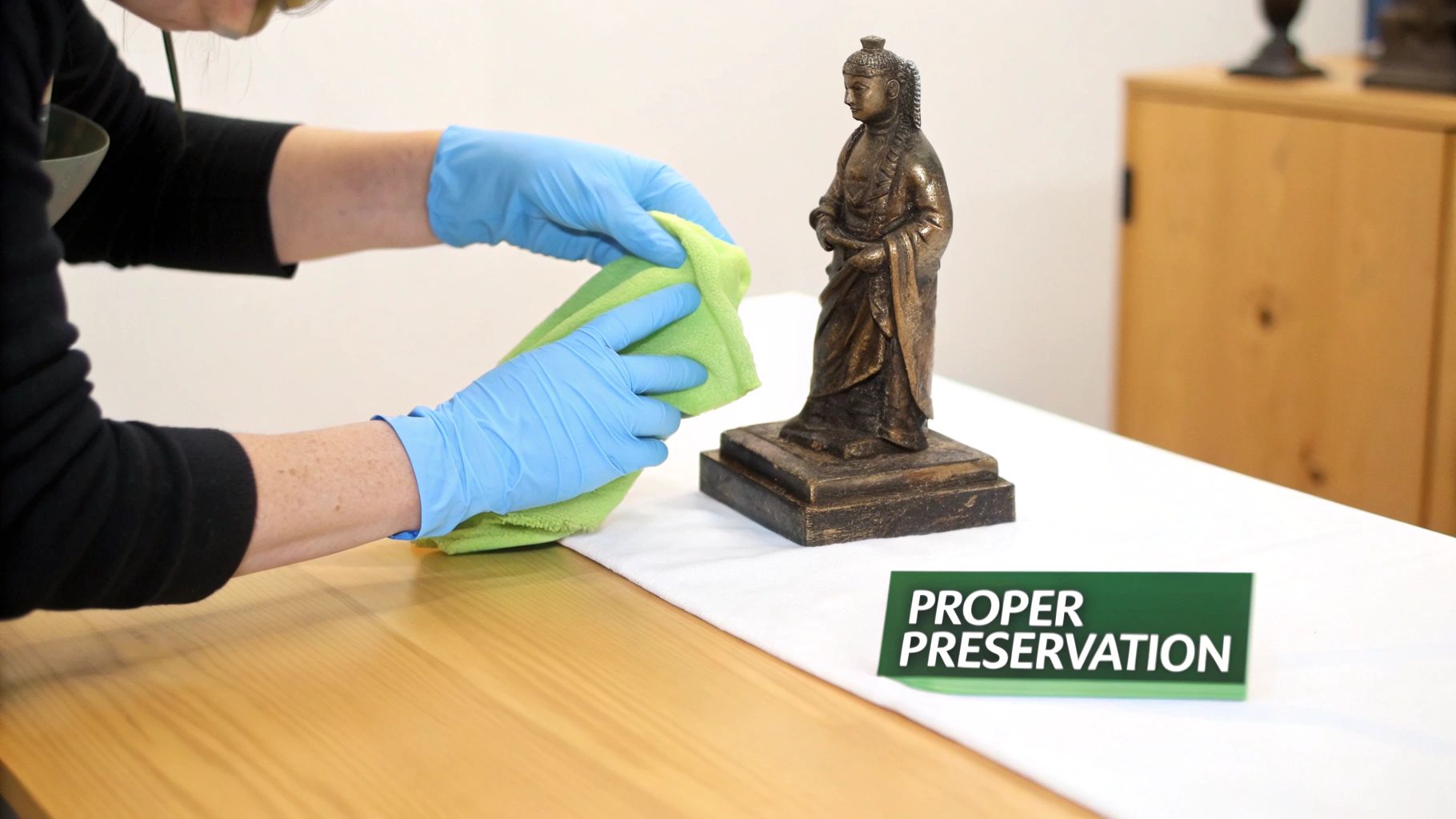
When you're looking at a bronze sculpture, those little foundry marks are much more than just tiny inscriptions. They are a huge part of what determines the piece's actual monetary value. A mark from a famous foundry, like Barbedienne or Roman Bronze Works, is like a seal of approval. It tells collectors and auction houses that the quality is top-notch, instantly making the sculpture more desirable and, of course, more expensive.
This link between the artist and their chosen foundry is absolutely crucial. Take, for example, a sculpture by Frederic Remington stamped with ROMAN BRONZE WORKS N.Y. That mark confirms it was cast by the specific foundry he trusted with his work. This powerful association between a master artist and a master craftsman assures buyers that the piece is authentic and historically significant, often resulting in much higher prices at auction.
The Role of Provenance and Quality
A foundry mark from a respected workshop establishes a clear history, or provenance, which is fundamental to figuring out what an antique is worth. A piece with a documented story tied to a well-known foundry will always be more valuable than an identical sculpture without a mark. The mark essentially guarantees the quality of the bronze alloy, the skill of the artisans who cast it, and how faithfully it represents the artist's original vision.
On the other hand, the lack of a mark can be a red flag. While it's true that not all authentic antique bronzes are marked, a missing stamp means you have to dig deeper and scrutinize other details like the patina and casting quality. A mark from an obscure or unlisted foundry usually results in a lower valuation simply because its history and quality are a mystery. You can learn more about how provenance shapes value in our guide on how to find the value of antiques.
Material Costs and Market Trends
Beyond the historical story, the raw material itself plays a part. The price of bronze directly affects how much it costs contemporary foundries to produce new work, and it also sets a baseline value for historical pieces. Market forces are always at play here.
A key factor influencing the art market is the global price of raw materials. The stability of these costs directly affects foundry profitability and the final price of new artworks.
For example, in early 2025, bronze prices in China—a major global supplier—held steady at around USD 8.5 per kilogram. This stability showed the market's strength even as energy costs rose. That price point has a ripple effect on everything from casting fees to the cost of new commissions, ultimately shaping the entire market for both modern and antique bronzes.
Telling Apart Foundry Marks and Artist Signatures
One of the first hurdles every collector faces is figuring out the difference between the artist's signature and the foundry's mark. It's a common point of confusion. They're often located right next to each other, but they tell you two completely different things about the sculpture in your hands.
Getting this right is absolutely essential for identifying and valuing a bronze. Think of it like this: the artist's signature is the claim to the idea or the original design. The foundry mark is the stamp of the workshop that physically produced the bronze cast. Both are critical parts of the sculpture’s provenance, but they answer different questions.
Key Visual and Stylistic Differences
The quickest way to tell them apart is to look closely at how they were made. Artist signatures are personal. Foundry marks are business.
Artist Signatures: These almost always look like an actual signature, often incised or carved into the model before casting. They have a handwritten feel, sometimes with flowing, cursive letters. The famous "A. Rodin" on an Auguste Rodin sculpture is a perfect example of this personal touch.
Foundry Marks: These are usually much more formal and uniform. They are typically impressed stamps with clean, block letters or a distinct logo. The mark "F. BARBEDIENNE, FONDEUR," for instance, is a classic, no-nonsense stamp that clearly identifies the workshop.
This stylistic difference is your most reliable clue. One is a personal autograph; the other is a corporate brand.
Common Placement on a Sculpture
While there are no hard-and-fast rules, foundries and artists tended to place their marks in fairly consistent spots. They wanted to sign the work without interfering with the art itself. Knowing the usual hiding places can save you a lot of time.
Foundries were especially fond of discreet locations. You’ll often find their stamps:
- On the back or side of the bronze base
- Along the lower rim or edge
- Tucked away under a fold of drapery or another less-obvious feature
The artist’s signature is usually nearby, often on the top of the base or near the feet of the figure—visible, but not distracting.
Expert Tip: When you’re examining a piece, make it a habit to hunt for both marks. A genuine work by a major artist that was cast at a top-tier foundry will almost always have both the signature and the stamp. Finding both is a strong indicator of authenticity and quality.
Once you train your eye to spot these differences in style and location, you'll be able to confidently separate the artist from the maker. This is a foundational skill for understanding the full story behind any bronze sculpture.
Spotting Fake and Forged Foundry Marks
Knowing how to identify foundry marks on bronze is a great start, but it's only half the battle. Just as important is developing an eye for what's fake. The art market, unfortunately, has its share of forgeries and reproductions, all made to fool unwary collectors. Learning to spot the red flags can save you from a very expensive mistake.
Often, a fake mark gives itself away through simple sloppiness. A forger might stamp a mark that doesn't match the known style of a foundry, or they might place it in a bizarre location on the piece. The most common tells, however, are marks that just look too crisp and new for the sculpture's supposed age.
The Problem of Surmoulage
One of the most popular tricks of the trade for fakers is a technique called surmoulage. This involves creating a new mold directly from a finished bronze sculpture, not from the artist's original plaster or clay model. It's a shortcut that saves time and money, but it always produces a lower-quality cast.
Because this new cast is a "copy of a copy," it will be slightly smaller than the original and will lose a significant amount of surface detail. This loss of definition is especially obvious when you look at the foundry mark and the artist's signature.
Key Takeaway: A genuine foundry mark, impressed into the original wax model before casting, will look sharp and clear. A mark on a surmoulage cast almost always appears soft, blurry, and indistinct, as if the fine details have been smoothed over.
Authentication Checklist for Bronze Foundry Marks
When you're examining a foundry mark, you have to look at the whole picture, not just the stamp. Forgers can get obsessed with getting the mark right but completely miss other crucial details. Honing your ability to see these inconsistencies is a core part of learning how to spot fake antiques.
To help you systematically evaluate a mark, I've put together a quick checklist. It compares what you'd expect to see on an authentic piece versus the common signs of a fake.
Authentication Checklist for Bronze Foundry Marks
| Characteristic | Authentic Mark | Potential Forgery |
|---|---|---|
| Clarity | Crisp, sharp, and well-defined edges. The impression feels integral to the bronze. | Soft, blurry, or indistinct. Details look "melted" or worn down. |
| Size & Detail | Matches the size and details of known, verified examples from the foundry. | Slightly smaller than authenticated marks, with a noticeable loss of fine detail. |
| Casting Quality | Found on a high-quality cast with sharp details and professional finishing. | Often paired with a poor-quality cast showing rough textures, pitting, or flaws. |
| Patina | The patina inside the mark is consistent with the patina on the rest of the sculpture. | Patina may be uneven, splotchy, or look painted on. It might be darker or lighter inside the mark. |
| Placement | Located in a standard, documented position for that particular foundry. | Placed in an unusual or illogical spot on the sculpture. |
Ultimately, the best way to confirm authenticity is to compare what you see with verified examples. Use museum archives, reputable auction house catalogs, and academic books as your guide. Even a tiny difference in a letter's font or the spacing between words can be the clue that exposes a forgery. By combining close visual inspection with solid research, you'll gain the confidence to tell a true historical piece from a clever imitation.
Frequently Asked Questions About Bronze Foundry Marks
Whether you're just starting your collection or have been at it for years, the world of bronze sculpture always has a few lingering questions. It’s common to run into a strange mark or an unusual piece that leaves even seasoned enthusiasts scratching their heads. This FAQ is designed to give you straightforward answers to the most common queries about foundry marks on bronze.
Think of this as your go-to reference when you're examining a sculpture and need a quick, practical answer.
Does Every Authentic Bronze Sculpture Have a Foundry Mark?
No, not always. This is probably one of the most important things for a collector to grasp. While a crisp mark from a respected foundry is a fantastic indicator of authenticity, the lack of one doesn't automatically mean you're looking at a fake. You have to consider the context.
For instance, many older bronzes cast before the mid-1800s won't have a mark because foundries simply didn't standardize that practice yet. It wasn't the norm. You'll also find cases where an artist ran their own small foundry; they might have just signed their name, seeing a separate foundry stamp as unnecessary.
The key takeaway? Always evaluate a sculpture as a whole. If a foundry mark is missing, you just have to lean more heavily on other clues—the quality of the artist's signature, the skill of the casting itself, the piece's style, and the age and quality of the patina.
Can a Foundry Mark Reveal the Exact Age of My Bronze?
It can give you some excellent clues, but rarely will it pinpoint an exact date. Some foundries did include dates in their marks, but that was definitely the exception. Think of the mark more as a historical signpost that helps you place the casting within a certain time frame.
Foundries often changed their stamps over the years. A mark might start as a simple monogram and later evolve into the foundry's full name, or the font might change. By comparing the specific mark on your sculpture to a foundry’s known timeline of marks, you can often narrow the casting date down to a specific period.
For the most accurate dating, you’ll want to combine what the foundry mark tells you with the artist's known career dates. Cross-referencing these two timelines is how the pros do it.
What Should I Do If I Cannot Identify a Foundry Mark?
This is a common frustration. You've found a clear mark, but it's not showing up in any of your reference books or online searches. When this happens, don't see it as a dead end. It just means it's time to call in an expert.
Here are your best bets for getting professional help:
- A certified art appraiser who focuses on sculpture.
- A museum curator who knows the period or style of your piece.
- A specialist at a reputable auction house that handles bronze sales.
These professionals have access to scholarly archives, deep auction records, and private databases that the public can't easily get to. When you reach out, be ready with clear, high-quality photos of the foundry mark, the artist's signature (if there is one), and the whole sculpture from several different angles. The more visual detail you provide, the better their chances of cracking the case.
Feeling overwhelmed by a mysterious mark or an inherited heirloom? Curio puts an antique expert in your pocket. Snap a photo to instantly identify your items, uncover their history, and get a quick appraisal. Download Curio today and let your treasures tell their story. Learn more about Curio.
